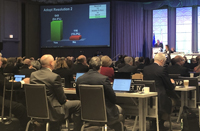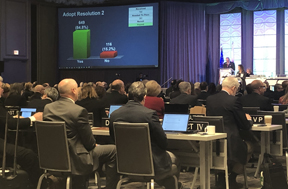!This story has an important update

AVMA VLC 288

VIN News Service photo
As it did last year (pictured), the House of Delegates gathers this week in Chicago for its annual winter meeting. Comprised of about 160 veterinarians representing state associations and allied entities, the House acts as the American Veterinary Medical Association's policymaking body.
Few topics debated in veterinary medicine are as divisive as cat declawing, and the American Veterinary Medical Association once again is entering the fray.
During the group's annual Veterinary Leadership Conference Jan. 10-11 in Chicago, the AVMA House of Delegates will discuss a number of proposed resolutions, including one intended to "simplify" the association's stance that decisions about declawing should remain between owners and their veterinarians.
Declawing procedures, known medically as non-therapeutic onychectomy, involve amputating the third phalanx, or bone, of a cat's toes.
The proposed revision reads:
"The AVMA discourages the declawing (onychectomy) of cats as an elective procedure and supports non-surgical alternatives to the procedure. However, the AVMA respects the veterinarian's right to use professional judgment when deciding how to best protect their individual patients' health and welfare. Therefore, it is incumbent upon the veterinarian to counsel the owner about the natural scratching behavior of cats, the alternatives to surgery, as well as the details of the procedure itself and subsequent potential complications (e.g., surgical, behavioral, maladaptive pain). Onychectomy is a surgical amputation and if performed, multimodal perioperative pain management must be utilized."
The AVMA first adopted a stance on onychectomy in 2003, encouraging veterinarians to educate clients that scratching is a normal feline behavior and that stopping the behavior by removing the cat's claws should be a last resort. The AVMA revised its stance in 2009 to specify that municipalities should not have jurisdiction to ban declawing and other licensed veterinary medical procedures. In 2014, the policy was revised again to characterize the procedure as an amputation and "major surgery."
Some government policymakers characterize it as "inhumane." On July 22, New York Gov. Andrew Cuomo signed the nation's first, and so far only, statewide declaw ban. The law stipulates that anyone caught declawing a cat in New York will face a fine of up to $1,000. Other states are considering similar proposals.
AVMA has lobbied against government intervention. Association officials say the latest proposed policy revision was prompted by the organization's regular cycle of reviewing policies every five years. The update, they say, would make the policy more consistent with those of the American Animal Hospital Association and the American Association of Feline Practitioners, which oppose for ethical reasons declawing any cat unless it's necessary for the cat's health.
The proposed AVMA policy leaves room for practitioners and their clients to declaw cats if they determine that circumstances merit it. For example, declawing a cat might be necessary for an elderly or immunocompromised owner for whom a cat scratch could cause serious infection or injury, officials assert. A statement about the draft policy's development reads: "Great care was taken to balance the fact that elective onychectomy does not directly benefit the cat and the reality that there are rare circumstances where declawing may be a valid option after alternative interventions have failed."
Given that House delegates represent 70 state, territorial and allied organizations, feedback on the resolution is likely to be mixed. While the profession as a whole historically has viewed onychectomy as a safe and reasonable way to stop scratching behaviors that could otherwise lead to the abandonment or euthanasia of cats, that's no longer the consensus. Some practitioners have stopped declawing in response to pressure from activists, some of whom bully and shame veterinarians who perform the procedure. Other veterinarians consider declawing a cat to be cruel and abusive.
That belief is shared by some government leaders. Long before New York outlawed the procedure statewide, a number of local jurisdictions banned declawing. In 2003, West Hollywood, California, adopted the nation's first city ordinance to criminalize feline onychetomy, eliciting opposition from the California Veterinary Medical Association. Seven other California cities followed, as well as Denver, which banned declawing in 2017. St. Louis became the latest municipality to join the anti-declaw movement when authorities enacted a citywide ban in December.
Resolutions: cribbing, microchipping and technology
Another animal welfare issue on the House agenda involves the AVMA's first-ever policy against devices used to curb cribbing in horses.
Cribbing, also called crib biting or wind sucking, is a behavior in which a horse gnaws on an object such as a door stall or fence railing, in the process sucking in air, which produces a characteristic grunting noise. The behavior, which might reflect boredom, restlessness or digestive issues, is associated with colic, potential harm to the teeth and property damage. According to the AVMA resolution, farriers and some practitioners attempt to curb cribbing by surgically placing metal hog rings through the incisors and around the teeth. But this act in turn can cause gingival damage, periodontal disease and abrasive wear to the teeth. "Unfortunately, this practice is not only prevalent in the lay industry but is also being performed by some veterinarians," the resolution states. The AVMA noted that the American Association of Equine Practitioners also is deliberating a policy against the use of hog rings to manage cribbing in horses.
On microchipping, a resolution calls for simplifying existing policy that an AVMA background statement calls "very cumbersome."
The proposed changes omit much of the current policy directing veterinarians on how and when to scan a patient for a microchip, as well as how and when to contact the person to whom the chip is registered.
"It is recognized that there are valid reasons to scan new patients and regularly scan existing patients, however, dictating in policy the precise situations, frequency, or procedure of such scanning may impinge on, or conflict with, state laws regarding property ownership," the statement says. "For example, if a veterinarian has already established a VCPR [veterinary-client-patient relationship] with a new client/animal, then discovers that the animal has a microchip of which the owner was unaware, the requirements and ability of the veterinarian to attempt to notify anyone about this situation is likely limited due to the existing VCPR."
The resolution also would rename the policy from "Microchips: The Objectives and Key Elements Needed for Effective Electronic Identification of Companion Dogs, Cats, Other Small Mammals, Birds, Fish, Reptiles, Amphibians and Equids" to "Microchip Identification of Companion Animals and Equids."
A new resolution on the use of technology in veterinary medicine is intended to update, simplify and combine multiple existing AVMA policies that support the ethical use of innovative technologies in veterinary medicine.
If approved, the new policy will supersede AVMA policies titled "Use of Technology, Including Biotechnology, in Veterinary Medicine and Animal Agriculture" and "Use of Innovative Technologies in Development of Drugs, Vaccines and Diagnostic Modalities."
Under the proposed policy, the "AVMA affirms and encourages the responsible and ethical development and use of technology for a variety of applications in veterinary medicine that can benefit and protect public health, animal health and welfare, and environmental health."
Other business
Apart from resolutions, House delegates will discuss the AVMA's proposed budget for fiscal year 2020-21, current membership numbers and the state of association-related insurance programs. The House also will host a forum for discussion on the use of cannabis in animals, the evolving role of telemedicine and potential liability concerns associated with the employment of student externs and practice volunteers.
Proposed policies drafted as a result of those talks likely will be considered by the House when it meets in July in San Diego during the AVMA Annual Convention.
Update: The AVMA House of Delegates approved all resolutions on its agenda. Delegates also passed recommendations for the AVMA to create guidelines on electronic communications between veterinarians and clients and a toolkit on liablity issues tied to employing student externs and volunteers.